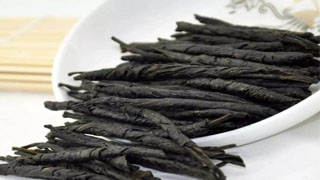
1. Alias
Ku Deng tea, Da Ye tea.
2. Plant morphology
Evergreen trees. The bark is reddish black or grayish black, rough; The small branches are thick, gray brown, and hairless. Leaves alternate, leathery or thick leathery, elongated elliptical or needle like elliptical in shape, with a short pointed or blunt tip at the top, a gradually narrowed base, small serrations at the edges, blunt teeth with black pointed tips, shiny on top, and hairless on both sides; The leaf veins are concave into grooves on top, with 10-14 veins on each side; The petiole has wings. White flowers, unisexual, dioecious. The male inflorescence is an axillary inflorescence, usually with 3-7 flowers and 4 sepal lobes, oval or triangular in shape; The corolla is wheel shaped, with 4 petals, inverted oval shaped, and 4 stamens shorter than the petals. The fruit is axillary, pseudoracemose, with a thick and robust main axis. The drupe is spherical in shape and red in color, with a disk-shaped persistent stigma at the top; The fruit stem is thick and sturdy, with four nuclei and an oblong shape.
3. Origin distribution
Born in valleys or sparse forests on mountain slopes, distributed in Guangdong, Anhui, Zhejiang, Guangxi and other places. Wild or cultivated.
4. Harvesting and processing
Harvesting in summer and autumn. Pick the leaves and dry them in the sun; Or stack the dry leaves neatly and tie them into small bundles.
5. Characteristics of medicinal herbs
Leaves are leathery. Complete and straight, in the shape of a long ellipse, with sparse pointed serrations on the leaf edge resembling thorns, smooth leaf surface, greenish yellow or greenish gray; The color of the back of the leaves is slightly lighter, and both the main and reticular veins are obvious. Qi is faint, taste bitter and slightly sweet.
6. Sexual Taste Returning to the Classics
Cold in nature, bitter and sweet in taste. Return to the liver meridian, lung meridian, and stomach meridian.
7. Effect and Function
Relieve wind, clear heat, relieve annoyance and cough, digest food and phlegm. A heat clearing and blood cooling medicine classified under the category of heat clearing drugs.
8. Clinical application
Take 6-9 grams and decoct. Used to treat fever, thirst, wind heat, headache, toothache, red eyes, ear discharge, damp heat dysentery.
9. Pharmacological research
It can significantly increase coronary flow and cerebral blood flow, protect acute myocardial ischemia, reduce cerebral vascular resistance and blood pressure, and improve the hypoxia tolerance of mice. It also has the effects of lowering blood lipids, anti fertility, and stimulating uterine smooth muscle. Subcutaneous or intraperitoneal injection of Kudingcha decoction has anti early pregnancy and anti implantation effects on rats. Water extract can increase the coronary flow of isolated guinea pig hearts, significantly improve the hypoxia tolerance of mice, prolong the survival time of hypoxic mice, and also have a protective effect on acute myocardial ischemia induced by posterior pituitary hormone in rats; After intravenous injection of water extract, it can significantly increase cerebral blood flow in anesthetized rabbits, reduce cerebral vascular resistance and blood pressure.
10. Chemical composition
Leaf contains components such as Sophora flavescens, α - coumarin, coumarin, β - coumarin, blackhair alcohol, β - sitosterol, dandelion extract, and ursolic acid. Fresh leaves contain bitter saponins, broad-leaved glycosides A and B.
11. Usage taboos
People with spleen and stomach deficiency and cold should take it with caution.
12. Compatibility prescription
① Treatment of oral inflammation: 30g Kuding tea, boil in water and swallow. (Zhejiang Medicinal Plant Chronicles)
② Treating burns: Take an appropriate amount of Kuding tea. Boil in water and wash outside, then apply leaf powder and tea oil. (Zhejiang Medicinal Plant Chronicles)
③ Treat external bleeding: Crush and grind fresh kudzu tea, apply juice, and apply; Grind the dried leaves into fine powder and apply with sesame oil. (Anhui Chinese Herbal Medicine)
⊙ The content of the article is for clinical reference only. Non TCM professionals are not allowed to test drugs.


